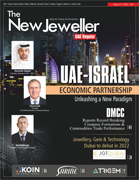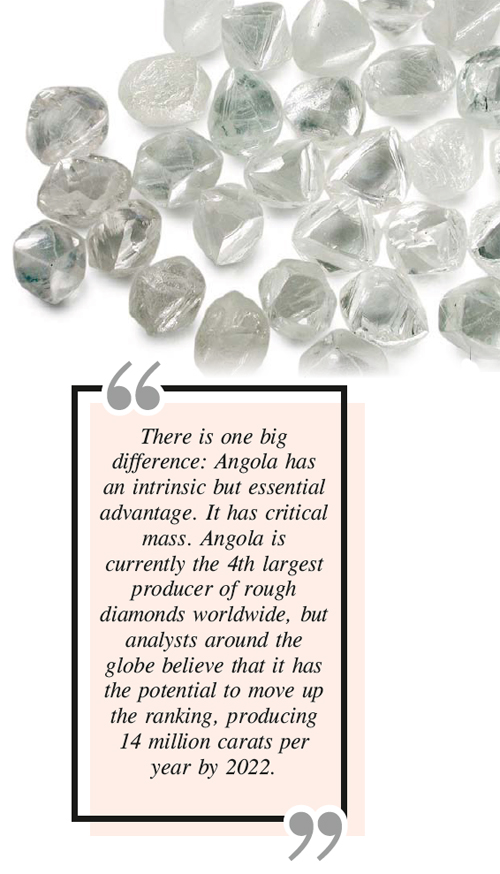
 |
|
| Home Technology / Education Events & News Archives Designs |
|
Angolan Diamond Bourse
Mr. Meeus, does this new challenge of Angolan Diamond Bourse remind you of work you did earlier in Dubai? Obviously, the task which lies ahead of an Angolan Diamond Bourse is not an easy one and will not be done in a couple of weeks or months. The same however could be said on the establishment of the Dubai Diamond Exchange, because when I arrived in 2006, there was hardly any trade in rough and polished. There were also no banks financing the trade. Dubai further also had no mines where diamonds can be found. As an anecdote, I also want to mention that everybody in the main trading centres said we would fail. Obviously, we didn’t. There is one big difference: Angola has an intrinsic but essential advantage. It has critical mass. Angola is currently the 4th largest producer of rough diamonds worldwide, but analysts around the globe believe that it has the potential to move up the ranking, producing 14 million carats per year by 2022. Angola is the only place in the world where diamond production will grow and Angola could become the 2nd largest producer by 2030. What makes the Angolan Diamond Bourse different from other Bourses? If you look at it with “old eyes”, there is only one diamond bourse in Africa, the Diamond Dealers Club of South Africa (DDCSA) and that is indeed a traditional bourse. 30 years ago when I joined the diamond trade, bourses basically were full of brokers. Hundreds of brokers, people that carried parcels from one office to another. Today, if you look at the bourses and offices in Antwerp, you will see that this role of brokers has largely disappeared. So, what is a diamond bourse then today, if the people that carry parcels from one place to another office are not there anymore? I believe that part of this role has been taken over by the tender houses and these tender houses are either part of a governmental or semigovernmental entity like in Antwerp the AWDC or in Dubai the DMCC or they are purely privately owned. In itself these activities consist of the essence of a Bourse. What is your opinion on the tender house activities in the main trading centres in the world? One may assume that Antwerp today is doing almost 120-140 tenders per annum. If we take an average of 100 transactions per tender, that means almost +60 transactions per working day or 1 every 8-9 minutes. This is an amazing amount of activity involving hundreds of companies, thousands of people, doing more than the total of Angola’s production. We also understand that Surat has entered the scene where a successful tender of above 80 million took place a month ago. Dubai is also now stepping up further in this role with the fantastic new facility in Almas and we wish the Dubai Diamond Exchange a lot of success. In the same perspective, Sodiam is in the process of analysing how to bring tender houses from Antwerp and Dubai to the Angolan Diamond Bourse. Do you know how all this will transpire for Angolas & in what time frame? 
The answer is clear: no, we don’t, but in a certain way, this is a bold new step not only for Sodiam and Angola but also for Africa. In other countries like Botswana and Namibia where De Beers’ presence was dominant, the beneficiation process focused mainly on creating jobs in the cutting industry. For Angola, we would aim at a structure which is more about today’s needs and bearing in mind the disruptive nature of technology. So, part of the goods would still go for polishing obviously, as it is foreseen in the Presidential Decrees. But at the same time, a certain percentage of the goods could go for tendering in the tender facility which we are building in the Angolan Diamond Bourse. We currently are figuring out what the critical mass is which is needed for this to be successful. We will do it carefully, cautiously and stepby- step. Sodiam is studying this carefully with our colleagues from the Ministry, Endiama and the mining community. Will you also integrate a deep-boiling facility and a gemmological academy in the Angolan Diamond Bourse? Obviously, as was also the case in Dubai, we are also in the process of examining how to integrate deep boiling facilities in the ADB. Deep boiling in Luanda could mean an added value of about an average of – at least 2% -- on 1.2 billion dollars, that is 24 million US dollars. It probably will be more. We are analysing the work of these organizations who are also active in Dubai and Antwerp. And of course, last but not least, the Angolan Diamond Bourse will have an academy where we will give courses on diamond grading and rough valuation and sorting and on anything which is needed to be successful in the international diamond trade. Can you give us some more details? Well, this is the time for Africa. There are many challenges lying ahead and therefore it is too early to go into particular details. What is important is to know that this bold new step for Angola and for Africa has been taken and that we will bring this to a good end. We are grateful that DMCC and DDE is reaching out to look for fields of cooperation. In certain areas, that is very welcome. Any closing remarks? It is my honour for the 2nd time in my life after DMCC and DDE to start a project from scratch and we - all of us - are determined to make it a success. Por último, mas não menos importante, teremos sucesso; não há razão para não o atingirmos. Juntem-se a nós, DMCC, para fazer disto um sucesso mútuo.
|